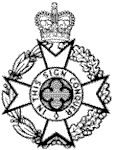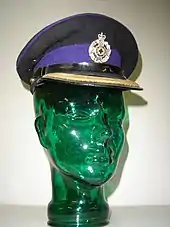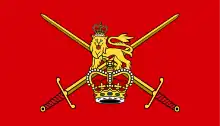Royal Army Chaplains' Department
The Royal Army Chaplains' Department (RAChD) is an all-officer department that provides ordained clergy to minister to the British Army.
| Royal Army Chaplains' Department | |
|---|---|
 Cap Badge of the Royal Army Chaplains' Department; for Jewish padres the Maltese Cross is replaced by a Star of David | |
| Active | 23 September 1796 – present |
| Country | |
| Branch | |
| Role | Chaplaincy |
| Garrison/HQ | Marlborough Lines, Andover |
| Motto(s) | "In this Sign Conquer" |
| March | Prince of Denmark's March (Trumpet Voluntary) |
| Commanders | |
| Chaplain General | The Rev. Michael Parker |
| Patron | The Queen |
| Insignia | |
| Tactical recognition flash |  |
History

 |
| Arms of the British Army |
|---|
| Combat Arms |
| Combat Support Arms |
| Combat Services |
|
|
The Army Chaplains' Department (AChD) was formed by Royal Warrant of 23 September 1796;[1] until then chaplains had been part of individual regiments, but not on the central establishment. Only Anglican chaplains were recruited until 1827, when Presbyterians were recognised, but not commissioned until 1858.[2] Roman Catholic chaplains were recruited from 1836, Methodist chaplains from 1881, and Jewish chaplains from 1892.[3] During the First World War some 4,400 Army Chaplains were recruited and 179 lost their lives on active service.[3] The department received the "Royal" prefix in February 1919.[3] During the Second World War another 96 British and 38 Commonwealth Army Chaplains lost their lives.[3]
From 1946 to 1996, the RAChD's Headquarters, Depot and Training Centre were at Bagshot Park in Surrey, now the home of The Duke and Duchess of Edinburgh.[4] In 1996, they moved to the joint service Armed Forces Chaplaincy Centre at Amport House near Andover, Hampshire.[5] Since 2020 the joint centre has been based at Beckett House, part of the Defence Academy of the United Kingdom, just outside Shrivenham, Oxfordshire.[6]
Role
Serving regular chaplains in the British Army can be Catholic, one of several Protestant denominations, or to the Jewish faith. Uniquely within the Army, the Royal Army Chaplains' Department has different cap badges for its Christian and Jewish officers.[7]
Army chaplains, although they are all commissioned officers of the British Army and wear uniform, do not have executive authority. They are unique within the Army in that they do not carry arms. Many chaplains have been decorated for bravery in action, including four awarded Victoria Crosses: James Adams, Noel Mellish, Theodore Hardy and William Addison.[8] At services on formal occasions, chaplains wear their medals and decorations on their clerical robes.[9]
The RAChD's motto is "In this Sign Conquer" as seen in the sky before the Battle of the Milvian Bridge by the Roman Emperor Constantine. Its regimental march, both quick and slow, is the Prince of Denmark's March, erroneously known as the Trumpet Voluntary.[10]
Museum
The Royal Army Chaplains' Museum is at Shrivenham, in a new building opened by the Countess of Wessex on 17 May 2022.[11] Its newly curated collection replaced the Museum of Army Chaplaincy which was at Amport House near Andover, Hampshire until 2019.[12]
Denominations
Chaplains are either classified as Jewish or as a member of one of the following denominational groups:[13]
- Anglican (Church of England, Church of Ireland, Church in Wales and Scottish Episcopal Church)
- Assemblies of God
- Baptist Union of Great Britain
- Church of Scotland
- Free Church of Scotland
- Churches in Communities International
- Congregational Federation
- Elim Pentecostal Church
- Methodist Church
- Presbyterian Church in Ireland
- Roman Catholic Church
- United Reformed Church
- Salvation Army
There are also religious advisors from other faiths.[14]
An Army chaplain is expected to minister to and provide pastoral care to any soldier who needs it, no matter their denomination or faith or lack of it.[15]
In 2004, Defence Minister Ivor Caplin said: “It is our aspiration to have armed forces which are representative of UK society as a whole.” The move might also help when dealing with soldiers in other armies from different faiths. At the time there were about 740 personnel that declared themselves to be from the four other main religions, but only Christian chaplains are employed by the MoD. The number of non religious MOD personnel including those in uniform numbered in the tens of thousands.[16]
In 2011, following a freedom of information request on Ministry of Defence spending on chaplaincy, the National Secular Society requested that £22m of spending should come directly from churches while professional counselling should continue to be funded by the taxpayer,[17] in order to better serve the non-religious in the military.[18] The proposal was rejected by the Church of England.[17]
In September 2021 Defence Humanists, through a submission to the Government’s Integrated Review of foreign policy, defence, security and international development, called for an independent review of pastoral support for the armed forces which takes into account the nation’s changing religion and belief demographics and the need for a multi-faith and belief approach.[19] As of 2022 there are no non-religious chaplains in the British armed forces although organisations such as Defence Humanists (previously known as the UK Armed Forces Humanist Association), the Non-Religious Pastoral Support Network and the Defence Secular Society continue to advocate for it.[20][19] The armed forces of the Netherlands have had Humanist chaplains since 1964, known as Humanist Counseling in the Dutch Armed Forces.[21]
Ranks

Chaplains are the only British Army officers who do not carry standard officer ranks. They are instead designated Chaplain to the Forces (CF) (e.g. "The Reverend John Smith CF"). They do, however, have grades which equate to the standard ranks and wear the insignia of the equivalent rank. Chaplains are usually addressed as "Padre" /ˈpɑːdreɪ/, never by their nominal military rank.
- Chaplain-General (CG) = Major-General
- Deputy Chaplain-General (DCG) = Brigadier
- Chaplain to the Forces 1st Class (CF1) = Colonel
- Chaplain to the Forces 2nd Class (CF2) = Lieutenant-Colonel
- Chaplain to the Forces 3rd Class (CF3) = Major
- Chaplain to the Forces 4th Class (CF4) = Captain
The senior Church of England chaplain is ranked within the church hierarchy as an archdeacon – he or she holds the appointment of Archdeacon for the Army whether or not he or she is also the Chaplain-General. The senior Roman Catholic Chaplain (usually a CF1) is sometimes ranked as a monsignor.[22]
List of Chaplains General
| Term Began | Term Ended | Name | Notes |
|---|---|---|---|
| 4 October 1796 | 1810 | John Gamble | Resigned[23] |
| 10 March 1810 | 1824 | John Owen | Died in position[24] |
| 12 July 1824 | 1844 | Robert Hodgson | Died in position[25] |
| 2 July 1846 | 1875 | George Gleig | Retired[26] |
| 7 April 1875 | 1884 | Piers Claughton | Died in position[27] |
| 8 February 1885 | 1 November 1901 | Cox Edghill | Retired[28] |
| 1 November 1901 | 1925 | John Taylor Smith | [29] |
| 1925 | 1931 | Alfred Jarvis | Resigned[30] |
| 1931 | 1939 | Ernest Thorold | [31] |
| 1939 | 1944 | Charles Symons | Retired[32] |
| 6 November 1944 | 1951 | Llewelyn Hughes | Resigned[32] |
| 6 November 1951 | 1960 | Victor Pike | Resigned[33] |
| 11 June 1960 | 1966 | Ivan Neill | [34] |
| 8 February 1966 | 1974 | John Youens | Retired[35] |
| 1 July 1974 | 1980 | Peter Mallett | [36] |
| 1980 | 31 December 1986 | Frank Johnston | [37] |
| 1 January 1987 | 1995 | James Harkness | Scottish Presbyterian, first non-Anglican Chaplain-General[37] |
| 3 February 1995 | 2000 | Victor Dobbin | Irish Presbyterian minister[38] |
| 13 May 2000 | 2004 | John Blackburn | [39] |
| 2004 | 2008 | David Wilkes | Methodist |
| 2008 | 2011 | Stephen Robbins | |
| 29 July 2011 | 2014 | Jonathan Woodhouse | Baptist[40] |
| September 2014 | 2018 | David Coulter | Church of Scotland |
| December 2018 | 2022 | Clinton Langston | |
| May 2022 | Present | Michael Parker | Methodist [41] |
Deputy Chaplain General
| Term Began | Term Ended | Name | Notes |
|---|---|---|---|
| 1915 | 1919 | Llewellyn Gwynne | [42] |
| 1941 | 1945 | Alfred Thomas Arthur Naylor | [43] |
| 1985 | 1986 | James Harkness | Church of Scotland, later Chaplain General |
| 1986 | 1989 | Tom Robinson | |
| 1989 | 1993 | Graham Roblin | |
| 1993 | 1995 | Alan Dean | |
| 1996 | 1999 | John Holliman | |
| 1999 | 2000 | John Blackburn | later Chaplain General |
| 2000 | 2004 | David Wilkes | Methodist, later Chaplain General |
| 2008 | 2011 | Jonathan Woodhouse | Baptist, later Chaplain General |
| 2011 | 2014 | David Coulter | Church of Scotland, later Chaplain General |
| 2014 | 2017 | Peter Eagles | |
| 2017 | 2018 | Clinton Langston | later Chaplain General |
| 2018 | 2020 | Michael Fava | Catholic[44][45] |
| 2020 | 2022 | Michael Parker | Methodist, later Chaplain General[46] |
| 2022 | Present | David Barrett | Methodist |
Some notable Army chaplains
- Michael Adler DSO
- William Addison VC
- Edward Armstrong Bennett MC
- Harry Blackburne DSO MC
- A. C. Bouquet
- Tubby Clayton (Founder, Toc H)
- Francis Lyon Cohen
- David Cooper
- Cox Edghill
- Willie Doyle MC
- Francis Gleeson
- Samuel Leighton Green MC
- Alexander Macdonell
- Theodore Hardy VC DSO MC
- James Harkness KCVO CB OBE
- Hugh Hornby MC
- Rupert Inglis, former England rugby international
- Geoffrey Studdert Kennedy MC ("Woodbine Willie")
- Noel Mellish VC
- George Smith (Padre at Rorke's Drift)
- Neville Talbot
- Maurice Wood
Gallery
.jpg.webp)
.jpg.webp)
.jpg.webp) Clinton Langston in choir dress with medals
Clinton Langston in choir dress with medals.jpg.webp) Padres in combat dress
Padres in combat dress
See also
- Royal Air Force Chaplains Branch
- Royal Navy Chaplaincy Service
- Bishop to the Forces (Anglican)
- Bishopric of the Forces (Roman Catholic)
- Military chaplain#United Kingdom
- International Military Chiefs of Chaplains Conference
- Religion in the United Kingdom
- Toc H
- Military archdeacons
- Category:Royal Army Chaplains' Department officers
Footnotes
- Snape 2008, p. 26.
- Snape 2008, p. 146.
- "History of Army Chaplains". Ministry of Defence. Retrieved 5 May 2014.
- "Bagshot Park". Retrieved 5 May 2014.
- "Army Forces Chaplaincy Centre". Defence Academy. Retrieved 5 May 2014.
- "Beckett House Conference (Religion and Defence)" (PDF). Defence Academy of the United Kingdom. 9 July 2021. Retrieved 13 June 2022.
- "Military Cap Badge Royal Army Chaplains Department (Jewish)". Intriguing history. 12 January 2012. Retrieved 5 May 2014.
- "Padre VC Holders". Retrieved 5 May 2014.
- "Army Dress Regulations (All ranks)" (PDF). Ministry of Defence. p. 577. Retrieved 14 June 2022.
- "Marches of the British Forces". Archived from the original on 12 June 2009. Retrieved 5 May 2014.
- "The Countess of Wessex visits Oxfordshire". Oxford County Council. 20 May 2022. Retrieved 13 June 2022.
- "Museum of Army Chaplaincy". Ministry of Defence. Retrieved 5 May 2014.
- "Royal Army Chaplains' Department". Ministry of Defence. Retrieved 30 November 2022.
- Taneja, Poonam (13 January 2014). "Army imam: Muslims can be good soldiers". BBC News. Retrieved 10 January 2019.
- "Royal Army Chaplains' Department". Ministry of Defence. Retrieved 5 May 2014.
- "United Kingdom: non-Christian chaplains to be appointed by armed forces". Religioscope. Retrieved 28 November 2022.
- McManus, John (15 October 2011). "Military chaplain funding queried by secular group". BBC News. Retrieved 8 May 2018.
- Bingham, John. "Military losing faith in God". Daily Telegraph. Retrieved 8 May 2018.
- "Defence Humanists calls for non-religious pastoral care in the armed forces". Humanists UK. Retrieved 28 November 2022.
- "MoD open to Humanist chaplains". The Scotsman. Retrieved 20 June 2021.
- "Humanistisch geestelijke verzorging". Humanistisch Verbond (in Dutch). Retrieved 14 June 2022.
- "They gave their today". Retrieved 5 May 2014.
- "No. 13938". The London Gazette. 4 October 1796. p. 945.
- "No. 16348". The London Gazette. 6 March 1810. p. 335.
- "No. 18044". The London Gazette. 13 July 1824. p. 1155.
- "No. 20620". The London Gazette. 7 July 1846. p. 2500.
- "No. 24199". The London Gazette. 13 April 1875. p. 2081.
- "No. 25442". The London Gazette. 17 February 1885. p. 677.
- "No. 27379". The London Gazette. 22 November 1901. p. 7653.
- "No. 33048". The London Gazette. 19 May 1925. p. 3374.
- "No. 34010". The London Gazette (Supplement). 29 December 1933. p. 3.
- "No. 36791". The London Gazette (Supplement). 10 November 1944. p. 5189.
- "No. 39375". The London Gazette (Supplement). 9 November 1951. p. 5772.
- "No. 42088". The London Gazette (Supplement). 8 July 1960. p. 4811.
- "No. 43898". The London Gazette (Supplement). 11 February 1966. p. 1755.
- "No. 46349". The London Gazette (Supplement). 24 September 1974. p. 7900.
- "No. 50799". The London Gazette (Supplement). 12 January 1987. p. 450.
- "No. 53946". The London Gazette (Supplement). 6 February 1995. p. 1747.
- "No. 55854". The London Gazette (Supplement). 23 May 2000. p. 5644.
- "No. 59866". The London Gazette (Supplement). 2 August 2011. p. 14713.
- "Methodist Chaplain announced as next Chaplain General for the British Army". Methodist Church. 17 November 2021. Retrieved 13 June 2022.
- Lord Balfour of Burleigh (22 September 1915). "THE DEPUTY CHAPLAIN-GENERAL". Parliamentary Debates (Hansard). United Kingdom: House of Lords. col. 836–839.
- "A Second World War D.S.O., and Great War O.B.E. group of seven : Reverend A.T.A. Naylor, Army Chaplain's Department". Bonhams.com. 12 March 2014. Retrieved 23 June 2017.
- "Top appointment for Catholic army chaplain". Independent Catholic News. 28 May 2018. Retrieved 10 January 2019.
- "No. 63164". The London Gazette (Supplement). 3 November 2020. p. 18604.
- Royal Army Chaplains' Department [@ArmyChaplaincy] (4 June 2020). "We are pleased to announce that The Revd Michael Parker CF, currently serving with @3rdUKDivision, will be the next Deputy Chaplain General. Padre Parker will take up the post in October. #calledtoserve" (Tweet). Retrieved 31 July 2021 – via Twitter.
Sources
- Snape, Michael (2008). The Royal Army Chaplains' Department, 1796–1953: Clergy Under Fire. Studies in modern British religious history. Boydell Press. ISBN 978-1-84383-346-8. Retrieved 14 June 2022.
Further reading
- Bergen, Doris. L., (ed), 2004. The Sword of the Lord: Military Chaplains from the First to the Twenty-First Century. University of Notre Dame Press ISBN 0-268-02176-7
- Kennedy, Geoffrey Anketell Studdert The Unutterable Beauty, ISBN 1-84685-110-6
- Loudon, Stephen H. Chaplains in Conflict. The Role of Army Chaplains since 1914. Avon Books, London: 1996. ISBN 1-86033-840-2
- MacDonald, David R. Padre E. C. Crosse and 'the Devonshire Epitaph': The Astonishing Story of One Man at the Battle of the Somme (with Antecedents to Today's 'Just War' Dialogue), ISBN 978-1-929569-45-8
- McLaren, Stuart John (ed.) Somewhere in Flanders. A Norfolk Padre in the Great War. The War Letters of the Revd Samuel Frederick Leighton Green MC, Army Chaplain 1916–1919. The Larks Press, Norfolk, UK (www.booksatlarkspress.co.uk): 2005. ISBN 1-904006-25-6
- Montell, Hugh (2002) A Chaplain's War. The Story of Noel Mellish VC, MC. ISBN 1-84394-008-6
- O'Rahilly, Alfred The Padre of Trench Street (about Jesuit Father William Doyle), ISBN 1-905363-15-X
- Purcell, William Woodbine Willie. An Anglican Incident. Being some account of the life and times of Geoffrey Anketell Studdert Kennedy, poet, prophet, seeker after truth, 1883–1929. London: 1962
- Smyth, Brigadier The Rt Hon. Sir John, Bt, VC, MC In This Sign Conquer. The Story of the Army Chaplains. London: 1968
- Teonge, Henry The Diary of Henry Teonge Chaplain on Board HM’s Ships Assistance, Bristol and Royal Oak 1675–1679. Edited by Sir E. Denison Ross and Eileen Power. London: Routledge, [1927] 2005.
- Thornton, Sybil "Buddhist Chaplains in the Field of Battle" in Buddhism in Practice, ed. Donald S. Lopez, Jr. (Princeton: Princeton University Press, 1995)
- Wilkinson, Alan The Church of England and the First World War. SPCK, London: 1978, reprinted by SCM, London: 1996. ISBN 0-334-02669-5
- Padres at War: Army chaplains bring comfort to the front line. Royal Army Chaplains' Department webpage. British Army official website.
External links
- Official website

- Royal Army Chaplains' Department at the National Army Museum, Chelsea